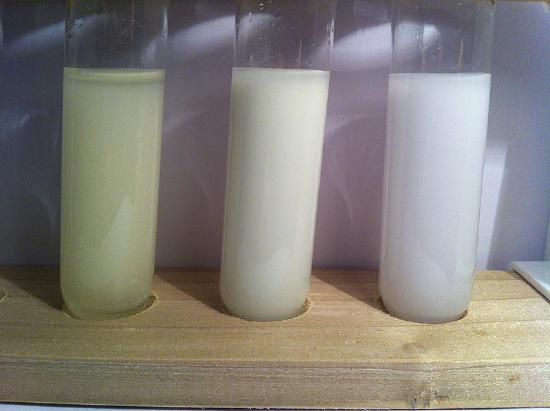7.7: Writing Chemical Equations for Reactions in Solution- Molecular, Complete Ionic, and Net Ionic Equations
- Page ID
- 48615
A typical precipitation reaction occurs when an aqueous solution of barium chloride is mixed with one containing sodium sulfate. The complete chemical equation can be written to describe what happens, and such an equation is useful in making chemical calculations.
\[\underbrace{\ce{BaCl2(aq) + Na2SO4(aq) -> BaSO4(s) + 2NaCl(aq)}}_{\text{Complete Chemical Equation}}\label{1} \]
However, Equation \(\ref{1}\) does not really represent the microscopic particles (that is, the ions) present in the solution. Below is the complete ionic equation:
\[ \underbrace{\ce{Ba^{2+}(aq) + \overbrace{2Cl^{-}(aq)}^{spectator} + \overbrace{2Na^{+}(aq)}^{spectator} + SO4^{2-}(aq) -> BaSO4(s) + \overbrace{2Na^{+}(aq)}^{spectator} + \overbrace{Cl^{-}(aq)}}^{\text{spectator}}}_{\text{Complete Ionic Equation}}\label{2} \]
Equation \(\ref{2}\) is rather cumbersome and includes so many different ions that it may be confusing. In any case, we are often interested in the independent behavior of ions, not the specific compound from which they came. A precipitate of \(\ce{BaSO4(s)}\) will form when any solution containing \(\ce{Ba^{2+}(aq)}\) is mixed with any solution containing \(\ce{SO4^{2–}(aq)}\) (provided concentrations are not extremely small). This happens independently of the \(\ce{Cl^{–}(aq)}\) and \(\ce{Na^+(aq)}\) ions in Equation \(\ref{2}\). These ions are called spectator ions because they do not participate in the reaction. When we want to emphasize the independent behavior of ions, a net ionic equation is written, omitting the spectator ions. For precipitation of \(\ce{BaSO_4}\) the net ionic equation is
\[\underbrace{\ce{Ba^{2+}(aq) + SO4^{2-}(aq) -> BaSO4(s)}}_{\text{Net Ionic Equation}} \label{3} \]
- When a solution of \(\ce{AgNO3}\) is added to a solution of \(\ce{CaCl2}\), insoluble \(\ce{AgCl}\) precipitates. Write three equations (complete chemical equation, complete ionic equation, and net ionic equation) that describe this process.
- Write the balanced net ionic equation to describe any reaction that occurs when the solutions of \(\ce{Na2SO4}\) and \(\ce{NH4I}\) are mixed.
Solution
| Equation Type | Example \(\PageIndex{1a}\) | Example \(\PageIndex{1b}\) |
|---|---|---|
| Complete Chemical Equation |
\(\ce{2AgNO3(aq) + CaCl2(aq) ->} \\ \ce{2AgCl(s) + Ca(NO3)2(aq)}\) The proper states and formulas of all products are written and the chemical equation is balanced. |
\(\ce{Na2SO4(aq) + 2NH4I(aq) ->} \\ \ce{2NaI(aq) + (NH4)2SO4(aq)}\) Both products are aqueous so there is no net ionic equation that can be written. |
| Complete Ionic Equation |
\(\ce{2Ag^+(aq) + 2NO3^{-}(aq) + Ca^{2+}(aq) + 2Cl^{-}(aq) -> } \\ \ce{2AgCl(s) + Ca^{2+}(aq) + 2NO3^{-}(aq)}\) AgCl is a solid so it does not break up into ions in solution. |
|
| Net Ionic Equation |
\(\ce{Ag^+(aq) + Cl^{-} (aq) -> AgCl(s)}\) All spectator ions are removed. The chemical equation is written using the lowest common coefficients. |
\(\ce{NaI}\) and \(\ce{(NH4)2SO4}\) are both soluble. No net ionic equation. There is no reaction. |
The occurrence or nonoccurrence of precipitates can be used to detect the presence or absence of various species in solution. A \(\ce{BaCl2}\) solution, for instance, is often used as a test for the presence of \(\ce{SO4^{2–}(aq)}\) ions. There are several insoluble salts of \(\ce{Ba}\), but they all dissolve in dilute acid except for \(\ce{BaSO4}\). Thus, if \(\ce{BaCl2}\) solution is added to an unknown solution which has previously been acidified, the occurrence of a white precipitate is proof of the presence of the \(\ce{SO4^{2–}}\) ion.

\(\ce{AgNO3}\) solutions are often used in a similar way to test for halide ions. If \(\ce{AgNO3}\) solution is added to an acidified unknown solution, a white precipitate indicates the presence of \(\ce{Cl^{–}}\) ions, a cream-colored precipitate indicates the presence of \(\ce{Br^{–}}\) ions, and a yellow precipitate indicates the presence of \(\ce{I^{–}}\) ions (Figure \(\PageIndex{1}\)). Further tests can then be made to see whether perhaps a mixture of these ions is present. When \(\ce{AgNO_3}\) is added to tap water, a white precipitate is almost always formed. The \(\ce{Cl^{–}}\) ions in tap water usually come from the \(\ce{Cl2}\) which is added to municipal water supplies to kill microorganisms.
Write balanced net ionic equations to describe any reaction that occurs when the following solutions are mixed.
- \(\ce{K2CO3 + SrCl2}\)
- \(\ce{FeSO4 + Ba(NO3)2 }\)
- Answer a
- \[\ce{Sr^{2+}(aq) + CO3^{2-} (aq) -> SrCO3 (s)} \nonumber \]
- Answer b
- \[\ce{Ba^{2+}(aq) + SO4^{2-} (aq) -> Ba(SO4) (s)} \nonumber \]
Precipitates are also used for quantitative analysis of solutions, that is, to determine the amount of solute or the mass of solute in a given solution. For this purpose it is often convenient to use the first of the three types of equations described above. Then the rules of stoichiometry may be applied.
Contributions & Attributions
Ed Vitz (Kutztown University), John W. Moore (UW-Madison), Justin Shorb (Hope College), Xavier Prat-Resina (University of Minnesota Rochester), Tim Wendorff, and Adam Hahn.

